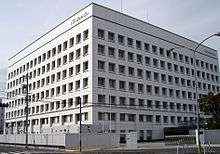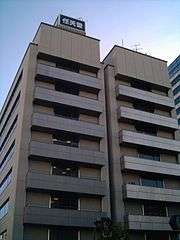List of Nintendo divisions
This is a list of the current divisions, subsidiaries and affiliates of Nintendo, a Japanese video game company.
International Headquarters and Distributors
Nintendo Co., Ltd. (NCL)
| Company | Location | Corporate role | |
|---|---|---|---|
| East Asia | |||
| Nintendo Co., Ltd. | NCL | Kyoto, Japan Tokyo, Japan |
Parent company. Japan publishing, sales, marketing and distribution.[1] |
| Nintendo Co., Ltd. | NHK | Hong Kong | Hong Kong and Taiwan publishing, sales, marketing and distribution. |
| Nintendo of Korea Co. Ltd. | NOK | Seoul, South Korea | South Korea publishing, sales, marketing and distribution. |
| iQue, Ltd. | N/A | Suzhou, China | China publishing, sales, marketing and distribution. |
 The exterior of Nintendo's main headquarters in Kyoto, Japan
The exterior of Nintendo's main headquarters in Kyoto, Japan Nintendo's Tokyo office
Nintendo's Tokyo office
Nintendo of America (NOA)
| Company | Location | Corporate role | |
|---|---|---|---|
| North America | |||
| Nintendo of America Inc. | NOA | Redmond, Washington Redwood City, California Atlanta, Georgia North Bend, Washington |
North American branch management. U.S. publishing, sales, marketing and distribution. |
| Nintendo of Canada Ltd. | NOCL | Vancouver, British Columbia Toronto, Ontario |
Canada sales, marketing and distribution. |
 The Nintendo of America headquarters in Redmond, United States
The Nintendo of America headquarters in Redmond, United States
Nintendo of Europe (NOE)
| Company | Location | Corporate role | |
|---|---|---|---|
| Europe | |||
| Nintendo of Europe GmbH | NOE | Frankfurt, Germany | European branch management. Publishing, sales, marketing and distribution. |
| Nintendo France S.A.R.L. | NFR | Cergy-Pontoise, France | France sales, marketing and distribution. |
| Nintendo Benelux B.V | NBX | Nieuwegein, The Netherlands | Benelux sales, marketing and distribution. |
| Nintendo Ibérica, S.A. | NIB | Madrid, Spain Lisbon, Portugal |
Spain and Portugal sales, marketing and distribution. |
| Nintendo Germany | ND | Germany sales, marketing and distribution. | |
| Nintendo Italy | NIT | Italy sales, marketing and distribution. | |
| Nintendo UK | NUK | Windsor, Berkshire | UK and Ireland sales, marketing and distribution. |
| Nintendo RU LLC. | NRU | Moscow, Russia | Russia sales, marketing and distribution. |
 Nintendo of Europe headquarters in Frankfurt, Germany
Nintendo of Europe headquarters in Frankfurt, Germany
Nintendo Australia (NAL)
| Company | Location | Corporate role | |
|---|---|---|---|
| Oceania | |||
| Nintendo Australia Pty. Ltd. | NAL | Melbourne, Victoria | Australia, New Zealand and the rest of Oceania publishing, sales, marketing and distribution. Represents The Pokémon Company in Oceania. |
Research & Development
Research & Development Divisions
Nintendo's internal Research & Development operations are divided into four main division: the Nintendo Entertainment Analysis & Development (or EAD), the main software development division of Nintendo, which focuses on internal-only video game development; the Nintendo Software Planning & Development (or SPD), which main focus is overseeing second and third-party licensing and development activity; the Nintendo Integrated Research & Development (or IRD), the main hardware development division of Nintendo, which focuses on home and handheld video game console development; and the Nintendo System Development (or SDD), which focuses on developing Nintendo Network services and Software Development Kits (SDK's) for Nintendo consoles and other experimental technology.
Research & Development Subsidiaries
Although most of the Research & Development is being done in Japan, there are some R&D facilities in the United States and Europe that are focused on developing software and hardware technologies used in Nintendo products. Although they all are subsidiaries of Nintendo (and therefore first party), they are often referred to as external resources when being involved in joint development processes with Nintendo's internal developers by the Japanese personal involved. This can be seen in a variety of "Iwata asks..." interviews.[2]
| Name | Location | Works |
|---|---|---|
| Nintendo Software Technology (NST) | Redmond, Washington, U.S. | Mario vs. Donkey Kong series, Wii Street U and other video games and applications.[3] |
| Nintendo Technology Development (NTD) | Redmond, Washington, U.S. | Video game console development and software technology. |
| Nintendo European Research & Development (NERD) | Paris, France | Various software technologies such as video compression and middleware.[4] |
| Nintendo Network Service Database (NSD) | Kyoto, Japan | Nintendo Network server maintenance. |
Software Development Subsidiaries
Most external first-party software development is being done in Japan, since the only overseas subsidiary is Retro Studios in the United States. Although these studios are all subsidiaries of Nintendo (and therefore first party), they are often referred to as external resources when being involved in joint development processes with Nintendo's internal developers by the Nintendo Software Planning & Development (or SPD) division.
| Name | Location | Works |
|---|---|---|
| 1-UP Studio | Tokyo, Japan | Magical Vacation series, Mother 3 and A Kappa's Trail. Currently, a development co-operation studio. |
| Creatures Inc. | Chiyoda, Tokyo, Japan | Pokémon Ranger, PokéPark and EarthBound (Mother) series (with HAL Laboratory and Brownie Brown). |
| HAL Laboratory | Chiyoda, Tokyo, Japan | Kirby, EarthBound and Super Smash Bros. series. |
| Monolith Soft | Tokyo, Japan | Xeno and Baten Kaitos series and Disaster: Day of Crisis.[5] |
| Kyoto, Japan | Development co-operation studio.[6] | |
| Nd Cube | Tokyo, Japan | Wii Party and Mario Party series. |
| Retro Studios | Austin, Texas, U.S. | Metroid Prime and Donkey Kong Country series. |
Software Development Partners
Since the release of the Family Computer/Nintendo Entertainment System, Nintendo has built up a large group of development partners, through publishing agreements and development collaboration. Most of these external Nintendo project are overseen by the Nintendo Software Planning & Development (or SPD) division.
Research & Development Partners
| Name | Works |
|---|---|
| Hatena | Miiverse (with Nintendo Network Business & Development), Flipnote Studio series (with Nintendo EAD Tokyo Group No. 1). |
| Vidyo | Wii U Chat (with Nintendo European Research & Development). |
Internal divisions
Corporate Analysis and Administration Division
- General Manager Tatsumi Kimishima
- Personnel Department
Finance Division
- General Manager Shigeyuki Takahashi
Manufacturing Division
- General Manager Hirokazu Shinshi
Marketing Division
- General Manager Satoshi Yamato
Licensing Division
- General Manager Susumu Tanaka
General Affairs
International Business - overseas projects.
Sales/market research
- HFI Inc.
- NES Merchandising Inc.
- NHR Inc.
- Nintendo Research, Inc.
Other affiliated companies
- The Seattle Mariners (The Baseball Club of Seattle, L.P.)
- The Pokémon Company
- Mario Club Co., Ltd.
- Warpstar Inc.
- Siras Inc.
- Fukuei Inc.
- JESNET Co. Ltd.[10]
Former affiliates
See also
References
- ↑ "Nintendo's most recent list of subsidiaries | GoNintendo - What are YOU waiting for?". GoNintendo. 2013-06-28. Retrieved 2013-10-14.
- ↑ "I didn't really go into this today, but Nintendo European Research and Development SAS France (NERD) helped us with our video player and Nintendo Software Technology (NST) helped with WebKit's JavaScript JIT, so this new Internet Browser really came about with help from so many different people outside the company.", Tetsuya Sasaki, Software Development & Design Department, see http://iwataasks.nintendo.com/interviews/#/wiiu/internet-browser/0/2 Retrieved November 9th 2012
- ↑ has helped with WebKit's JavaScript JIT, see http://iwataasks.nintendo.com/interviews/#/wiiu/internet-browser/0/2 Retrieved November 9th 2012
- ↑ formerly known as Mobiclip, has developed the videoplayer of the Wii U Internet Browser, see http://iwataasks.nintendo.com/interviews/#/wiiu/internet-browser/0/2 Retrieved November 9th 2012
- ↑ "IGN: Monolith Software (JP)". Games.ign.com. 2011-04-29. Retrieved 2011-05-25.
- ↑ "Monolith Soft war an Zelda: A Link Between Worlds beteiligt". Nintendo-Online.de. 2013-11-15. Retrieved 2014-04-19.
- ↑ "IGN: Ambrella (Marigul)". Games.ign.com. 2011-09-14. Retrieved 2011-10-26.
- ↑ "Monster Games". Mgiracing.com. 2005-02-07. Retrieved 2011-05-25.
- ↑ "IGN: Noise (Marigul)". Games.ign.com. 2011-04-29. Retrieved 2011-05-25.
- ↑ https://www.nintendo.co.jp/ir/pdf/2016/160825e.pdf
- Nintendo Annual Report 2006
- Nintendo International Distributors
- Nintendo of America Jobs
- N-Sider.com Nintendo Revolution FAQ
- Gamecubicle: Nintendo Expands International Operations